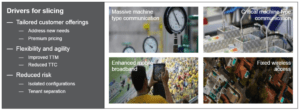Twitter Feed
SourceConnecte! Marketplace With A Mission
Earlier this year, GC GlobalNet launched a new breed of B2B e-commerce sites. Curated by Kevin L. Jackson, SourceConnecte (with an “eâ€) went live with three strategic goals in mind: Efficiently leverage modern…
Potential vs. Reality: Is Edge Computing Real?
Edge computing provides compute, storage, and networking resources close to devices generating traffic. Its benefits are based on an ability to provide new services capable of meeting stringent operational requirements…
Enabling Digital Transformation
Digital transformation integrates technology into all areas of an organization’s business or mission. Its fundamental purpose is to create and deliver innovative and industry-changing products and services to a global…
The ThinkShield Story Part 1: The Challenge
The cybersecurity challenge seems to be growing daily. Threats are becoming more sophisticated, and attacks are becoming more destructive while the corporate world’s response seems to resemble a deer…
CIO dream team: Who’s in and why?
Today’s CIO navigates the twin challenges of enabling new business models and managing rapid technological change. Cloud computing strategies are now table stakes. CIOs must make complex decisions about using…
Digital Transformation and the Mainframe
Digital transformation infuses digital technology into all areas of an organization’s business or mission. Its fundamental purpose is to create and deliver innovative and industry-changing digital products and services to…
Composable Architecture Q&A. Are you ready?
Q: Is it time for my company to jump on the composable architecture bandwagon? A: Composable architectures are quickly becoming essential to the modern enterprise. Citing a recent Forrester study:…
Increase Productivity by Reducing Technology Distraction: Lessons from Forrester Research
Workplace productivity is hurt every day by the very technology developed and purchased to improve it. Forrester announced this surprising conclusion in their latest “How To Wake Up From The Nightmare…
Unveiling the end-to-end capabilities for the networked society
An Interview with Henrik Basilier By Kevin L. Jackson The telecom industry is rapidly moving towards a future in which networks must have the capabilities of delivering services with the…
AT&T Finance Solutions GM on Shrimping, Software, and CX
Helping clients address the trends and challenges presented by the Financial Services industry is the main focus for René Dufrene in his role as General Manager of Finance Solutions at…
 The Internet of Things (IoT) has quickly become the next “be all to end all” in information technology. Touted as how cloud computing will connect everyday things together, it is also feared as the real- life instantiation of The Terminator’s Skynet, where sentient robots team with an omnipresent and all-knowing entity that uses technology to control, and ultimately destroy, all of humanity.
The Internet of Things (IoT) has quickly become the next “be all to end all” in information technology. Touted as how cloud computing will connect everyday things together, it is also feared as the real- life instantiation of The Terminator’s Skynet, where sentient robots team with an omnipresent and all-knowing entity that uses technology to control, and ultimately destroy, all of humanity.
Not there yet
Lucky for the humans among us, the technical capabilities of both cloud computing and IoT are way behind these Orwellian fears. Although the technology is promising, research and technical hurdles still abound. Challenges include:
- Datasets that span multiple continents and are independently managed by hundreds of suppliers and distributors;
- Volume and velocity of IoT dataflows exceed the capacity ad capability of any single centralized datacenter;
- Current inability to conduct “Big IoT” data processing across multiple distributed datacenters due to technical issues related to basic service stack for datacenter computing infrastructure, massive data processing models, trusted data management services, data-intensive workflow computing; and
- Benchmark limitations associated with heterogeneous datacenter application kernels.
Despite these current challenges, the blending of Things and cloud computing can deliver real value today in the creation of “Information Excellence”. Joe Weinman, author of “Cloudonomics: The Business Value of Cloud Computing”, eloquently explains this in his new book, “Digital Disciplines: Attaining Market Leadership via the Cloud, Big Data, Social, Mobile, and the Internet of Things”, information excellence is an extension of traditional operational excellence and its traditional static process design towards a business model that leverages real-time data to maximize process throughput and minimize process costs.[1]
Using cloud to optimize productivity
Also known as dynamic optimization, “Solving these types of problems requires big data collected in real time from things and people, processed in near real time through an optimal combination of edge
and cloud, and then enacted through people and things.” This approach is aggressively used by modern distribution companies when they abandon fixed delivery routes in favor of dynamic rerouting that minimizes fuel, carbon footprint, labor costs and capital requirements while simultaneously maximizing customer satisfaction.
Broader use of dynamic optimization can also have an effect on how governments can leverage cloud computing services to improve society at large. While it is well known that delivery companies such as UPS avoid left turns in the construction of delivery routes to improve productivity, New York City has recently requested that Google help reduce left turns for Google Maps users to enhance pedestrian safety.[2]
Even more exciting than this are possible subsequent business enhancements Weinman envisions which include:
- Solution Leadership – Connecting products and services via cloud computing in order to enable ongoing customer relationships, encouraging stickiness and transforming one-time transactions focused on sales to ongoing subscription relationships focused on customer outcomes
- Collective Intimacy – Using cloud computing to collect, aggregate and process data in order to personalize services and recommendations; and
- Accelerated Innovation – Connecting firms with problems to prospective solvers through idea markets, challenges and innovation networks.
Although security and privacy of personally identifiable information (PII) remain vexing problems, the use of anonymized and aggregated data to improve business processes avoids many of the pitfalls attached with improving services for an individual. A less obtrusive approach to IoT could also avoid many of the legal and regulatory obstacles associated with the storage and transmission of PII data. Companies that have successfully replaced traditionally static business processes with data-centric dynamic optimization and information excellence are well known and include:
- Airbnb
- Uber
- Netflix
- Amazon
Data-centric, service-centric means excellence
The lesson here is that a data-centric approach to business process improvement may be the true low hanging fruit when it comes to leveraging cloud computing quickly and profitably. These companies have also left behind the product-centric, regionally managed, manufacturing economic model in order to embrace the new model of service-centric, globally managed and networked economies. By targeting information excellence as the next step up from operational excellence, a legacy business can be fairly quickly renovated into a modern data-driven enterprise. Information excellence also enables customer personalization, process flexibility and business agility, all the key components needed for corporate success today.
[1] Joe Weinman, Digital Disciplines: Attaining Market Leadership via the Cloud, Big Data, Social, Mobile, and the Internet of Things (Wiley CIO, 2015).
[2] Sarah Goodyear, “New York Wants Google Maps to Discourage Left Turns,” CityLab from The Atlantic, July 9, 2015
This post was written as part of the Dell Insight Partners program, which provides news and analysis about the evolving world of tech. For more on these topics, visit Dell’s thought leadership site Power More. Dell sponsored this article, but the opinions are my own and don’t necessarily represent Dell’s positions or strategies.
( Thank you. If you enjoyed this article, get free updates by email or RSS – © Copyright Kevin L. Jackson 2015)
Cloud Computing
- CPUcoin Expands CPU/GPU Power Sharing with Cudo Ventures Enterprise Network Partnership
- CPUcoin Expands CPU/GPU Power Sharing with Cudo Ventures Enterprise Network Partnership
- Route1 Announces Q2 2019 Financial Results
- CPUcoin Expands CPU/GPU Power Sharing with Cudo Ventures Enterprise Network Partnership
- ChannelAdvisor to Present at the D.A. Davidson 18th Annual Technology Conference
Cybersecurity
- Route1 Announces Q2 2019 Financial Results
- FIRST US BANCSHARES, INC. DECLARES CASH DIVIDEND
- Business Continuity Management Planning Solution Market is Expected to Grow ~ US$ 1.6 Bn by the end of 2029 - PMR
- Atos delivers Quantum-Learning-as-a-Service to Xofia to enable artificial intelligence solutions
- New Ares IoT Botnet discovered on Android OS based Set-Top Boxes












